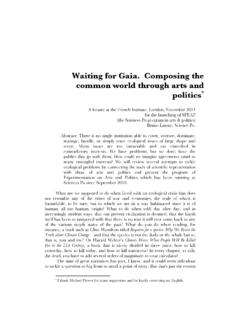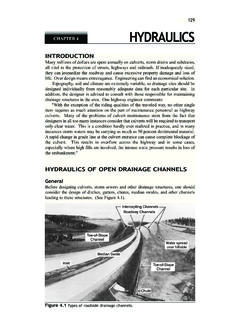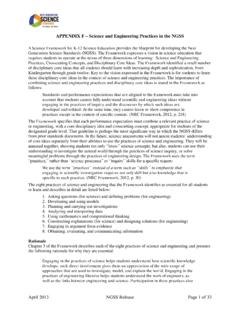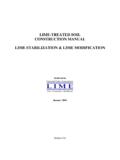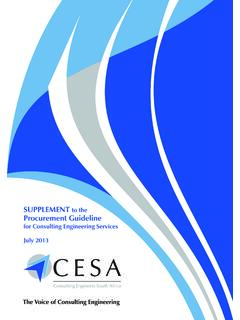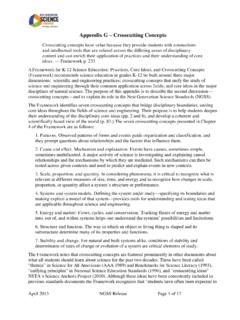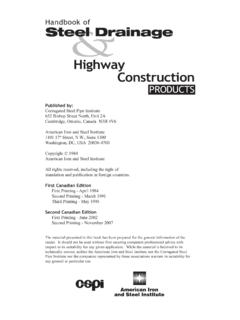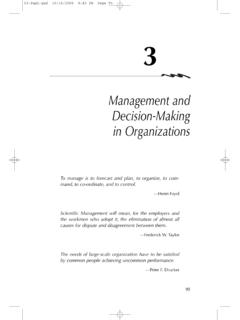Transcription of 10 Mundane Artifacts’’ - Bruno Latour
1 10 Where Are the Missing Masses? The Sociology of a Few Mundane artifacts ''. Bruno Latour One of the most popular and powerful ways of resolving the technological determinism/. social constructivism dichotomy in technology studies is the actor network approach. Those advocating the actor network approach agree with the social constructivist claim that sociotechnical systems are developed through negotiations between people, institutions, and organizations. But they make the additional interesting argument that artifacts are part of these negotiations as well. This is not to say that machines think like people do and decide how they will act, but their behavior or nature often has a comparable role.
2 Actor network theorists argue that the material world pushes back on people because of its phys- ical structure and design. People are free to interpret the precise meaning of an artifact, but they can't simply tell an automobile engine that it should get 100 miles per gallon. The laws of nature and the capacities of a particular design limit the ways in which artifacts can be integrated into a sociotechnical system. In this chapter, one of the foremost contrib- utors to the actor network approach, Bruno Latour , explores how artifacts can be deliber- ately designed to both replace human action and constrain and shape the actions of other humans.
3 His study demonstrates how people can act at a distance'' through the technol- ogies they create and implement and how, from a user's perspective, a technology can ap- pear to determine or compel certain actions. He argues that even technologies that are so commonplace that we don't even think about them can shape the decisions we make, the effects our actions have, and the way we move through the world. Technologies play such an important role in mediating human relationships, Latour argues, that we cannot under- stand how societies work without an understanding of how technologies shape our every- day lives.
4 Latour 's study of the relationship between producers, machines, and users demonstrates how certain values and political goals can be achieved through the construc- tion and employment of technologies. Again, might not the glory of the machines consist in their being without this same boasted gift of language? Silence,'' it has been said by one writer, is a virtue which render us agree- able to our fellow-creatures.''. Samuel Butler (Erewhon, chap. 23). Early this morning, I was in a bad mood and decided to break a law and start my car without buckling my seat belt.
5 My car usually does not want to start before I buckle the belt. It first flashes a red light FASTEN YOUR SEAT BELT!,'' then an alarm sounds; it is From Wiebe E. Bijker and John Law, eds., Shaping Technology/Building Society: Studies in Sociotechnical Change (Cambridge, Mass.: MIT Press, 1992), pp. 225 258. Reprinted with permission. 152 Bruno Latour so high pitched, so relentless, so repetitive, that I cannot stand it. After ten seconds I. swear and put on the belt. This time, I stood the alarm for twenty seconds and then gave in. My mood had worsened quite a bit, but I was at peace with the law at least with that law.
6 I wished to break it, but I could not. Where is the morality? In me, a human driver, dominated by the mindless power of an artifact? Or in the artifact forc- ing me, a mindless human, to obey the law that I freely accepted when I get my driver's license? Of course, I could have put on my seat belt before the light flashed and the alarm sounded, incorporating in my own self the good behavior that everyone . the car, the law, the police expected of me. Or else, some devious engineer could have linked the engine ignition to an electric sensor in the seat belt, so that I could not even have started the car before having put it on.
7 Where would the morality be in those two extreme cases? In the electric currents flowing in the machine between the switch and the sensor? Or in the electric currents flowing down my spine in the automatism of my routinized behavior? In both cases the result would be the same from an outside observer say a watchful policeman: this assembly of a driver and a car obeys the law in such a way that it is impossible for a car to be at the same time moving AND to have the driver without the belt on. A law of the excluded middle has been built, rendering logically inconceivable as well as morally unbearable a driver without a seat belt.
8 Not quite. Because I feel so irritated to be forced to behave well that I instruct my garage mechanics to unlink the switch and the sensor. The excluded middle is back in! There is at least one car that is both on the move and without a seat belt on its driver mine. This was without counting on the cleverness of engineers. They now invent a seat belt that politely makes way for me when I open the door and then straps me as politely but very tightly when I close the door. Now there is no escape. The only way not to have the seat belt on is to leave the door wide open, which is rather dangerous at high speed.
9 Exit the excluded middle. The program of action1 IF a car is moving, THEN. the driver has a seat belt'' is enforced. It has become logically no, it has become socio- logically impossible to drive without wearing the belt. I cannot be bad anymore. I, plus the car, plus the dozens of patented engineers, plus the police are making me be moral (figure ). According to some physicists, there is not enough mass in the universe to balance the accounts that cosmologists make of it. They are looking everywhere for the missing mass'' that could add up to the nice expected total.
10 It is the same with sociol- ogists. They are constantly looking, somewhat desperately, for social links sturdy enough to tie all of us together or for moral laws that would be inflexible enough to make us behave properly. When adding up social ties, all does not balance. Soft humans and weak moralities are all sociologists can get. The society they try to recom- pose with bodies and norms constantly crumbles. Something is missing, something that should be strongly social and highly moral. Where can they find it? Every- where, but they too often refuse to see it in spite of much new work in the sociology of I expect sociologists to be much more fortunate than cosmologists, because they will soon discover their missing mass.



